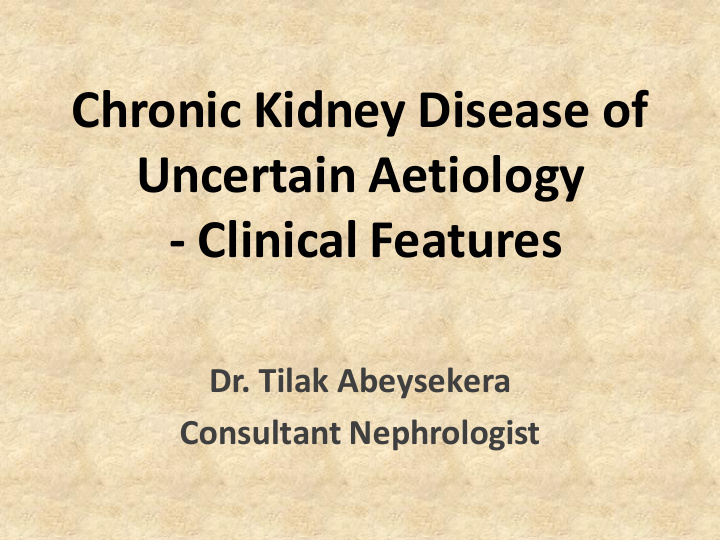



Chronic Kidney Disease of Uncertain Aetiology - Clinical Features Dr. Tilak Abeysekera Consultant Nephrologist
Geographical Distribution
Dry Zone
Factors Considered for the Diagnosis of CKDu • >5 years stay in the endemic region • Dipstick proteinuria + and above • No known identifiable cause for CKD • No H/O of diabetes / long standing uncontrolled hypertension 4 4
Prevalence of Non Communicable Diseases • Community-based Blood Pressure n= 504 • apparently healthy >140/90 mmHg • Sinhala n=154 Dipstick test for • males proteinuria and glycosuria • Age 20-70 yrs proteinuria n=350 and/or • living in endemic area glysosuria for at least 10 yrs n=24 HbA1c n=326 HbA1c >6.5% 43% of the n=17 apparently healthy Controls SCr >1.2 mg/dl n=286 population and/or A1M>15.5 mg/L SCr and A1M n=23 n=309 5
MINIMAL CHANGE 0% NORMAL MCGN 2% SLE 3% 2% REFLUX 2% CHRONIC IgA 5% PYELONEPHRITIS GLOMERULAR 9% SCLEROSIS 9% CHRONIC INTESTITIAL FIBROSIS 7% FSGS 7% ESRD 3% CHRONIC TUBULOINTESTIAL NEPHRITIS 38% DIFFERENTIAL DIAGNOSIS ESRF/CHRONIC TUBULOINTESTITIAL IN RENAL HISTOLOGY DISEASE TEACHING HOSPITAL 8% ANURADHAPURA FROM JULY2006 TO 2008 Jan (n=268 ) 6
Differential Diagnosis of Renal Biopsy in Giradurukotte 2006 (n=41) 7
Occupation – Farmers
Characteristics of CKDu • Majority were males • Between 40-70yrs • Insidious onset • Presented during late stages
Clinical Features • Insidious onset • Slowly progressive • Asymptomatic until advanced stage • Some present with backache, joint pains, abdominal ( flank ) pain, febrile feeling towards the end of the day, dysuria and feeling unwell.
Family History 14% have similarly affected first-degree relatives.
Genetic Susceptibility- Familial Clustering in CKDu Dr Surendra ra Ramachandra ran Oration on- SLMA- July y 2013
SLC13A3- Sodium dicarboxylate cotransporter 3 • Location- basolateral membrane of human renal proximal tubules , liver, brain, and placenta • Diabetic nephropathy- one of the most likely genes to affect the renal function Bento et al. (2008) Genomics 92(4): 226-234. • Hypertension- suggestive association with blood pressure Simino et al. (2011) Am J Hypertens 24(11): 1227 – 1233. • Renal fibrosis- potentially useful molecular predictor of CKD progression Ju et al. (2009) Am J Pathol 174(6): 2073 – 2085.
• KCNA10 - human voltage-gated K channel located in the heart, renal vasculature, and proximal tubular cells. Thus, it may have a role in regulation of blood pressure • LAMB2 - known to be associated with congenital nephrotic and nephritic syndromes • SLC39A8 - known to be involved in damage to the kidney tissue
Oedema Oedema occour at late stage of the disease
Hypertension In early stages of disease hypertension is usually mild and labile. In advanced disease hypertension is frequent.
Anaemia • Not different from anaemia of CKD • Usually normocytic normochromic • Mild in early disease • Severity increases with progression of disease
Characteristics of CKDu ctd. • No uroepithelial tumours as seen in Balkan Nephropathy • No specific features seen in CVS, RS, CNS,GIT and skin to suggest an aetiology
Urine Analysis • Minor and intermittent proteinuria • Urinary sediment is normal
kD Marker 1 2 3 4 5 6 250 150 100 95 75 67 albumin 53.7 50 45 37 32 a 1 microglobulin 25 24 Retinol binding Protein? 15 16.6 Protein 1 ? 10?
Ultrasonography • Smooth outline • Bilateral small kidneys • Loss of corticomedullary demarcation • Echogenic
Pathological Changes • Interstitial inflammation with tibulitis • Periglomerular fibrosis • Perivascular fibrosis • Focal interstitial hypocelleular fibrosis • Tubular atrophy • Glomerular sclerosis
Interstitial Inflammation with Tubulitis, Tubular Atrophy, Interstitial Fibrosis 57
Periglomerular Fibrosis
Perivascular Fibrosis
Focus of Tubular Atrophy
Sclerosed Glomeruli and Fibrosis
Dental Fluorosis
Skeletal Fluorosis
• > 100,000 people are currently affected • Number of deaths secondary to CKD in the affected region currently approximates 5000/year
How We Screened Standard Dipstick - ve + ve Urine Full Report Serum Creatinin Recheck at periodic Diagnostic Creatinin Clearence health evaluation Evaluation Serum Protein, Calcium, Phosphate Full Blood Count Ultra Sound Scan K.U.B Treatment Consultation
32 10-11 February 2006
10-11 February 2006 33
Future • Microalbuminuria • Alpha 1 Microglobulin • Beta 2 Microglobulin • Serum Creatinine/ Cystatin C • A combination of tests?
Prevention of Further Progression • Control of hypertension • Restriction of dietary proteins • Attention on drinking water – Fluoride filters • Abstinence from smoking & alcohol • Not to use drugs that can harm kidneys • Early referral to nephrologist • Regular medical attention • Reduction of protienurea
Management of ESRD • Dialysis • Kidney transplantation
Recommend
More recommend